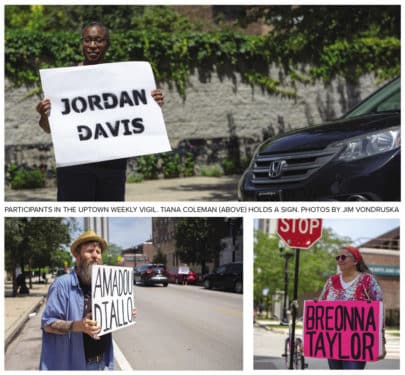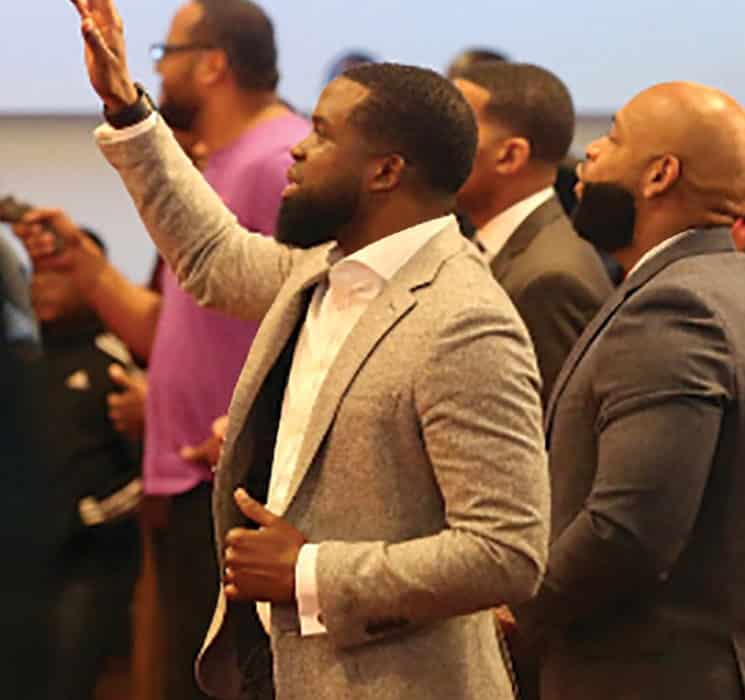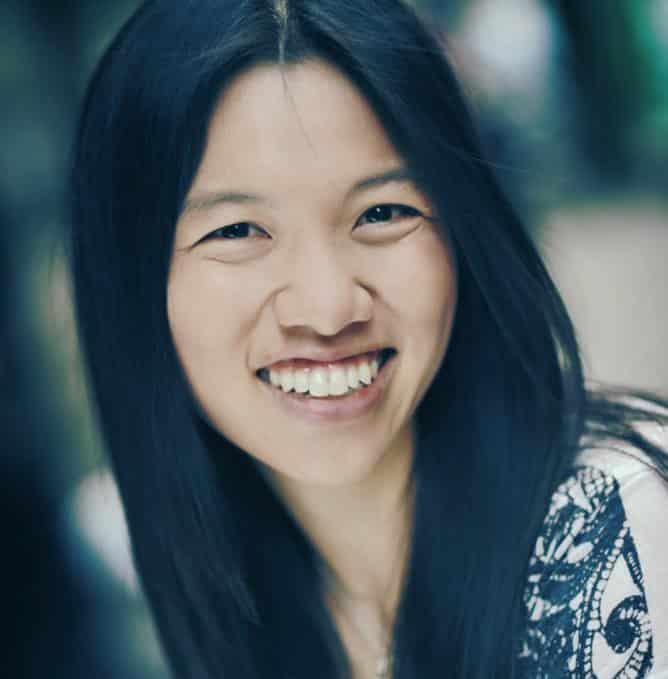Bias, discrimination, and abuse are culminating in a heightened sense of stress
Every Sunday afternoon for more than a year, Tiana Coleman has stood near the intersection of Sheridan Road and Wilson Avenue in Uptown, holding up a stark poster bearing a single hand-lettered name. The name changes, but the cause is the same.
Sometimes, she’ll stand for 15 minutes, sometimes for 30 minutes, sometimes for the full hour of the weekly community vigil.
Once, the sign she held said Tony McDade.
Once, it was for Atatiana Jefferson.
Once, for Daunte Wright. For Breonna Taylor. For Rekia Boyd. For George Floyd. For another Black person killed by police.
“I want to tell each person’s story, so I never hold the same name twice,” says Coleman, whose friend started the Uptown silent vigil after George Floyd’s murder.
The vigil has served as a balm for Coleman — a way for her to channel her despair and trauma over an endless cycle of deaths of people of color. A way for her to deal with the racial trauma of the past several years, of the news of another Black person killed by police officers.
The names and the deaths continue to mount. So, too, do the graphic images, bodycam videos, cell phone footage, and social media posts all bearing witness to the trauma and abuse that people of color experience on an ongoing basis.

There’s a name for this particular form of psychological stress: racial trauma. And saying its name helps people to better understand the source of the trauma and catalyze a personal response.
Racial trauma’s mental toll
Medical experts, therapists, and activists say this race-based stress must be named, addressed, and treated for communities of color to heal.
More people are thinking about how direct and indirect experiences of racism have affected them spiritually, emotionally, and physically, says Sheila Wise Rowe, author of the book, Healing Racial Trauma: The Road to Resilience.
The national nonprofit Mental Health America refers to racial trauma as a mental and emotional injury resulting from ethnic discrimination, racism, and hate crimes. Any individual who has experienced an emotionally painful racist encounter is at risk of suffering from racial trauma.
A counselor who focuses on offering spiritual direction, Wise Rowe says racial trauma manifests itself when a child or adult experiences incidents of racism, “whether it was historical racism from our ancestors, interpersonal, or just from trying to navigate through life in America and having to be confronted with systemic racism.”
Denika McMillen, 45, a licensed clinical social worker at Evolution Counseling in Naperville, says it’s important for racial trauma to be acknowledged and validated.
“Racial trauma is definitely nothing new here in America. It’s part of the white supremacist culture our country was founded upon,” McMillen says.
The trauma can result in post-traumatic stress disorder (PTSD), which often goes unrecognized. “As we continue to try to deny that this is really a deep, touching area for people of color, we will continue to have it go unnamed. Just imagine if people could be diagnosed with race-related PTSD, what impact it could make in the world,” McMillen says.
People of color are carrying unhealed racial trauma.
In her book, Wise Rowe says racial trauma symptoms surface from emotional and physical assaults, vicarious trauma, microaggressions, and racial gaslighting. It is also personal and can be passed on through generations in the form of historical trauma and transgenerational trauma.
“People of color are carrying unhealed racial trauma,” Wise Rowe says.
Brittani James, MD, co-founder of the Institute for Antiracism in Medicine and an assistant professor of clinical family and community medicine at the University of Illinois Chicago College of Medicine, points out that mere demands for people of color to “constantly have to prove” the existence of racial trauma is, in itself, a stress-inducing experience.
“This, to me, is another manifestation of racism, which is the erasure of our pain,” James says. “If you’re a Black woman, it adds another layer to it.”
Racial trauma, James adds, is often cyclic, constant, and unforgiving.
“There is the burden of just being in situations that are mentally stressful,” she says, such as getting passed over for a promotion, constant verbal sniping, repeated microaggressions, and an unbalanced legal system.
Racial trauma can also manifest itself through the internalization of racist ideas and stereotypes, such as when a person is treated poorly and then feels that they’re inadequate.
“That is what racism does to us,” James says. “It causes us to internalize false, harmful, toxic beliefs about ourselves that limit our view of our own potential.”
On an emotional level, the micro-aggressions mount and cause an increasing mental health burden. “Racism has an effect on us, and it causes damage,” Wise Rowe says.
The physical toll
Then, there is what racial trauma does to the human body.
James says even a single traumatic event raises cortisol and provokes an adrenaline response. As a family doctor in Chicago’s South Shore neighborhood, she constantly sees the repeated effect of racial trauma.
“I see what chronic oppression does to your body,” she says. “When you’re in a Black body, it’s just constant. There’s nowhere to go. So that stress raises your cortisol, increases inflammation, weakens your immune system, makes you prone to chronic disease, diabetes, blood pressure, all those things.”
Racial justice advocate Kathy Khang, a Libertyville resident, is familiar with the microaggressions. Khang, who wrote the book, Raise Your Voice: Why We Stay Silent and How to Speak Up, recalls a conversation in which a man repeated a derogatory statement he had heard about her.
“That was alarming and charged with racial and gender dynamics,” she says. “I felt my heart rate elevating. I felt extremely unsafe in that conversation.”
McMillen adds that avoiding things that could trigger a stress response is a form of self-care. Just because iPhone video or bodycam footage exists of unarmed people of color being killed by police officers, for instance, does not mean you need to watch it. McMillen, who is Black, says she has never watched the entire nine minutes and 29 seconds of phone video showing the murder of George Floyd.
“I won’t do that because that in itself is going to be traumatic,” she says. “It’s already traumatic enough that he’s dead.”
In response to racial trauma, Khang has created a protected virtual space, leading twice-weekly Zoom yoga sessions open only to women of color.
It’s important to have trusted relationships and a strong community to heal from racial trauma, she says.
“Racism always feels like it is an individual act committed by an individual person. And usually, it’s systemic. It’s cultural, perpetuated by systems and communities. And so that is why the healing from it — the unraveling — all of that has to happen in community,” Khang says.
During the yoga sessions, Khang encourages rituals, even something as simple as lighting a candle or holding an object, to calm the body and protect space for oneself.
Khang also helps women in her classes focus on pranayama breath work. “It’s specific breath work, calming our nervous system, or giving ourselves some energy when we are feeling defeated,” she says. “So in that space, I try to remind us of the messages that we need to hear — and can tell one another — because the trauma in the world tells us otherwise.”
Grieving through the process
In Bronzeville, Charlie Dates, PhD, the senior pastor of Progressive Baptist Church, says whenever a video or news item comes out about the unjust death of a person of color, “My first instinct is to think of their family and to grieve with their loved ones, to recognize that they are human and that their lives have been wrongfully taken. Their families are in difficult, difficult spaces.”

Acknowledging the grief — and the fact that it can continue in cyclic and generational ways — has become a part of healing racial trauma. Healing often means channeling that grief into resistance and activism.
“It’s healthy because we lean on our ancestors who also had to revolt or fight back or fight for basic human rights and against injustices,” McMillen says. “I really do think that fighting the systems that oppress us is a way to get back your sense of self.”
As Dates counsels his congregation to look to Jesus in their grief, he also encourages them to add their voices “to a chorus of others” who will make legislative and practical change.
“I recognize that I live somewhere between the already and the not-yet,” he says. “Things are already better than what they were years ago, but they are not yet what they ought to be or what they will be. And so that gives me a bit more patience to endure.”
Meanwhile, across the city in Uptown, Tiana Coleman continues to hold her signs every Sunday. Often, friends join her. And sometimes, a person she doesn’t know will walk past and ask to join. She hands them a poster with a name — more than 100 now — so they can stand alongside her.
For more than a year, Coleman and her friends have stood facing traffic and pedestrians with their signs, often hearing frequent horn honks of solidarity.
That recognition helps in the effort to heal racial trauma.
“You see Black people come through crying,” Coleman says. “I believe they’re feeling reaffirmed and also like, ‘We matter.’”
Pastor Charlie Dates, phd, leads his congregation at Progressive Baptist Church. Photo by Myron Hicks. Originally published in the Fall/Winter 2021 print issue.

Erin Chan Ding is a Chicago-area journalist and editor who writes about travel, fitness, trends, tech, and the intersection of race and identity.










